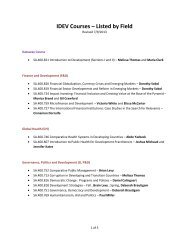Tunisia: Understanding Conflict 2012 - Johns Hopkins School of ...
Tunisia: Understanding Conflict 2012 - Johns Hopkins School of ...
Tunisia: Understanding Conflict 2012 - Johns Hopkins School of ...
Create successful ePaper yourself
Turn your PDF publications into a flip-book with our unique Google optimized e-Paper software.
As <strong>Tunisia</strong> led the movement, its democratic success will take on symbolic value for<br />
other countries in the region. Additionally, China is one <strong>of</strong> <strong>Tunisia</strong>’s most active new<br />
trading partners. Between 2000 and 2009, trade increased tenfold with China. Thus<br />
China also has an interest in the country’s stability and could be called upon accordingly<br />
to provide foreign assistance. Given China’s preference for funding infrastructure<br />
projects, the <strong>Tunisia</strong>n government could negotiate to have China provide the resources to<br />
complete several major tourist infrastructure projects that were put on hold due to the<br />
global financial crisis.<br />
Additionally, the government has failed to develop and implement a detailed,<br />
comprehensive strategy for reducing unemployment. This can be attributed to the lack <strong>of</strong><br />
experience <strong>of</strong> the current government <strong>of</strong>ficials, the majority <strong>of</strong> which did not serve under<br />
the Ben Ali regime. While the Ennahdha party has outlined important goals for reducing<br />
unemployment in its 365 point program, it has yet to develop a comprehensive strategy<br />
for achieving these goals. Instead, the government has been implementing ad hoc<br />
measures that have failed to produce concrete results. In order to be more effective, the<br />
government should tie its efforts to reduce unemployment to a more developed strategy.<br />
Long-Term Issues<br />
As seen in Figure 1 above, the youth unemployment rate will naturally fall to a<br />
manageable rate by the end <strong>of</strong> the decade if the GDP growth rate is sustained at 4 to 5%.<br />
Therefore, in the long term, encouraging economic growth and addressing several<br />
structural unemployment issues should be a sufficient strategy for addressing<br />
unemployment. In order to encourage economic growth, the government faces the longterm<br />
challenges <strong>of</strong> strengthening the private sector and encouraging foreign direct<br />
investment. Additionally, the government must develop certain sectors, including<br />
telecommunications and tourism, which are job-intensive and employ high-skill laborers.<br />
A last long-term issue is the education system, which is currently failing to adequately<br />
prepare university graduates to enter the workforce. Addressing these issues, which will<br />
be discussed further below, will generally boost economic growth and address structural<br />
unemployment issues.<br />
180
















